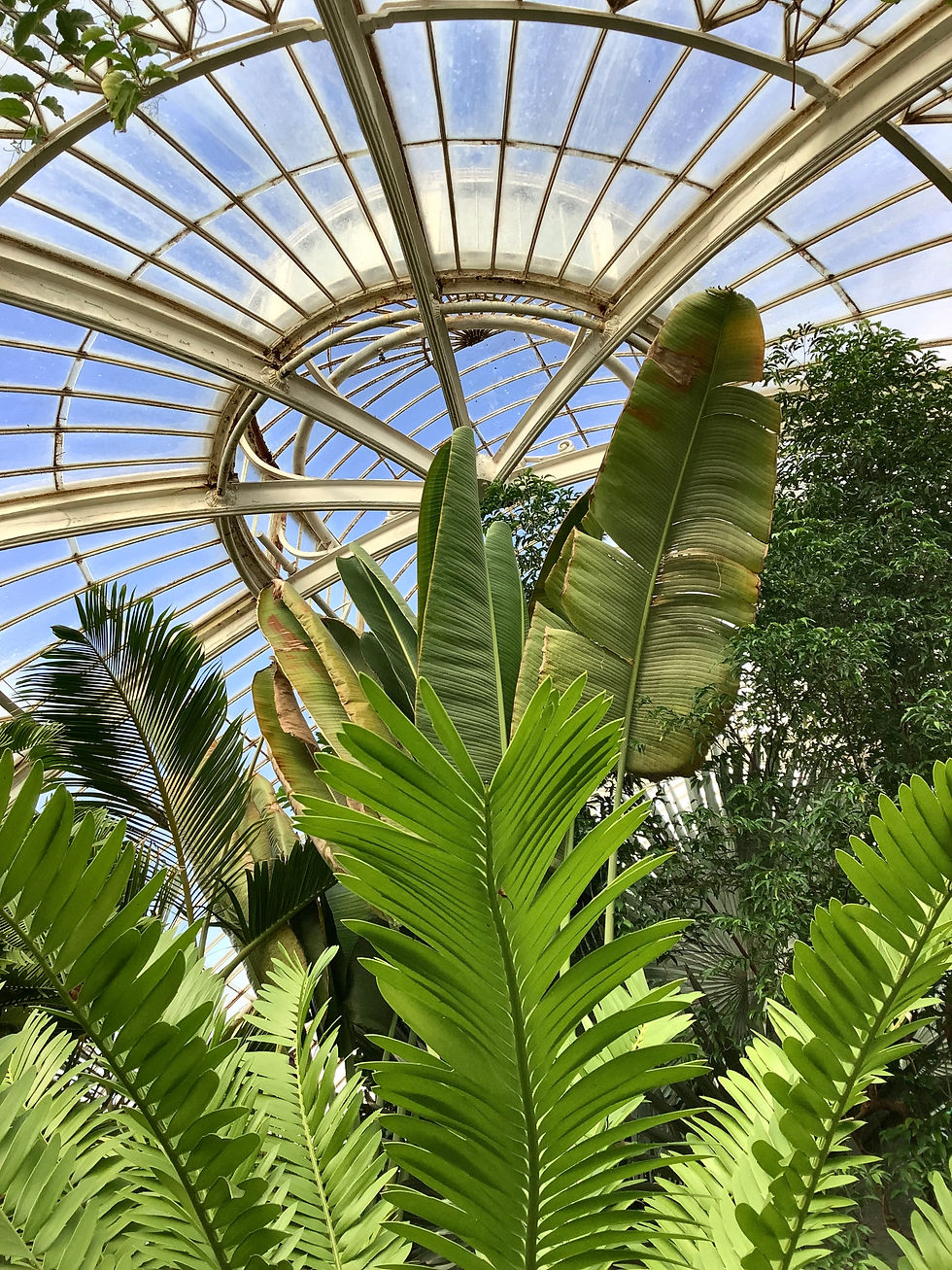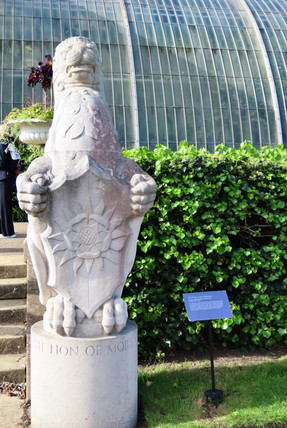The History of Kew Gardens
- Kathy J Ellis

- Oct 26
- 7 min read

The US friend I mentioned in the introduction to my Travel Page was here for her annual visit to Italy, and we took our traditional short trip. This time it was to London (with a quick peek at Oxford, too). One of the things we did was visit Kew Gardens and have high tea. I had never heard of the gardens that I recall. It was interesting and a lovely park. The grounds are beautiful, relaxing, and so interesting. The green hop-on/hop-off bus helped us cover a lot of ground, and it wasn't crowded. I recommend visiting if you ever have the chance.
Kew Gardens started as a royal family's private leisure park, but it grew to become the central organizing hub of the British Empire for botanical resources and science.
In 2003, UNESCO recognized the Kew Gardens as a World Heritage Site. It holds one of the largest and most diverse collections of living plants in the world (around 27,000), and its Herbarium is the largest in the world, holding over 8.5 million dried specimens of plants and fungi.
In partnership with organizations across more than 95 countries, the Millennium Seed Bank holds over 2.4 billion seeds from around 40,000 species, making it the world's largest seed bank.
(For more information, please check out the references and this video of how seeds are processed and The Millennium Seed Bank at Wakehurst)
Seed conservation is imperative to the survival of life on Earth. Anyone who eats should understand the need for biodiversity. Plant diversity keeps ecosystems healthy, supports pollination, soil life, and natural pest control. But as large industrial farms expand and grow just a few crops, they wipe out habitats, strip soils of nutrients, and reduce the variety of life our food systems depend on.
Whenever possible, support your local farmers!
The Georgian Beginning (1700–1770)
Kew Gardens began as a quiet, private area for the Georgian royal family. They used the land as a retreat away from the intense public life of the court in London. Yeah, the royals had it rough escaping the pressures of palace life to unwind among manicured lawns, exotic plants, and tea under the pagoda.
In 1759, Princess Augusta established her Physic and Exotic Garden, and it is the traditionally accepted date for the establishment of the Botanical Garden, marking the formal beginning of its scientific purpose. The Princess transformed the royal retreat into important botanical gardens, and by 1768, her herbaceous collection contained more than 2,700 species.
Marianne North (1830-1890)

Fast forward a century, and Marianne North, a Victorian-era botanical artist and explorer, contributed to Kew Gardens through her artwork, enriching the cultural and educational mission through her global botanical artwork and Kew's international botanical network. Her work is displayed at the Marianne North Gallery. Unfortunately the gallery was closed when we were there. We would have loved to see here illustrations.
Ms. North was a painter and botanist who painted the plants she encountered in her travels. Some were previously undiscovered, and one genus and four new species were named in her honour. She travelled alone, from Canada, America, Brazil, Jamaica, Japan, Borneo, demonstrating great independence rarely seen in women of that era.

Landscape and Architecture
The design of the early gardens was influenced by some of the most famous figures in the English Landscape Movement. I didn't know there was an English Landscape Movement and had to do some research. The players in that movement were Charles Bridgeman, William Kent, and Lancelot' Capability' Brown. Brown's work from the 1760s can still be seen in the surviving pastoral landscape and the Hollow Walk, which has since been replanted as the Rhododendron Dell.
Princess Augusta also commissioned the architect Sir William Chambers (1723–1796) to design several ornamental structures and "fanciful garden buildings".

Chambers' most famous design at Kew is the Great Pagoda. This 10-storey, 163-foot-tall structure was considered a "supreme example of Chinoiserie," an aesthetic style reflecting Chinese art and design. The Pagoda was designed to be a "window for the British people into Chinese culture," not a religious monument.
Chambers also designed the Ruined Arch (1759–60) and the original Temple of Aeolus (1763). This period shows how the initial interest in the exotic was primarily aesthetic—a cultural precursor to the economic and scientific focus that would soon take over.
The Scientific Foundation and the Imperial Network (1771–1840)
After Princess Augusta died in 1772, Kew came under the influence of Sir Joseph Banks (1743–1820), a wealthy English naturalist and botanist.
Banks had recently returned in 1771 from his journey with Captain Cook to the South Seas, a voyage considered the first ever undertaken specifically for scientific exploration. When he returned, Banks became Kew's unofficial Director.
Banks had a vision. He was instrumental in Kew's evolution into a world-leading scientific centre. He advised King George III, leveraged his position as President of the Royal Society for 41 years, and established a huge global network. He dispatched botanists around the world to collect plants, and his own voyage brought back 30,000 plant specimens, including 1,400 species that Europeans had never documented before.
Banks was a key link between the older tradition of amateur British science and the emerging modern scientific community. Unfortunately, he was also known for his pro-slavery opinions and for advising on the colonization of Australia.
The Birth of Modern Kew
The deaths of both George III and Sir Joseph Banks in 1820 created a period of uncertainty and neglect of the gardens, leading to a public outcry. This is when the gardens shifted to direct state control and became a national centre for botanical science and imperial administration. The "Imperial Botanical Service" was created with Kew serving as the central headquarters coordinating botanical efforts across the globe.
In 1840, Kew was formally adopted as a national botanical garden, and on April 1, 1841, Sir William Hooker, a well-respected Professor of Botany at the University of Glasgow, took over as Director. This date is widely considered the "birth of the modern Kew".
Iron, Glass, and Global Authority (1841–1900)
William Hooker and his son, Sir Joseph D. Hooker (who later succeeded him), transformed Kew physically and intellectually. Massive glasshouses were built to manage the influx of exotic plants, and the institution became the world authority on plant classification.
The Great Glasshouses

The Palm House (1844–1848): Designed by Decimus Burton and built by Richard Turner, this structure was revolutionary. It utilized innovative wrought iron construction techniques borrowed directly from the shipbuilding industry. The Palm House was built for research and designed to maintain a rainforest-like climate (kept at 18º C / 64º F), allowing scientists to study tropical specimens directly.
The Temperate House (1859–1898): This was built in phases over several decades. The huge number of species was growing and needed more space, so the Temperate House also grew in phases over several decades.
The Herbarium
In 1853, William Hooker established the Herbarium 1853 as the institution's commitment to science grew. The initial collection was stored in the Hunter House. By acquiring valuable collections, including the East India Company collection in 1858, the Herbarium grew quickly. By 1860, with 1.2 million specimens, Kew's Herbarium became the largest in the world.
Here is an interesting part of the story: the British imperial ambitions drove the centralization of plant knowledge. Joseph Hooker, the second Director, said in 1899: "I cannot control the expansion of Kew Herbarium because I cannot control the expansion of the Empire". Apparently, collecting and classifying botanical data was seen as essential to consolidating imperial power.

Economic Botany and Resource
During the 19th century, Kew Gardens was the most influential botanical institution of the British Empire. Its job was to manage the plants, coordinating the collection, analysis, and redistribution of plant resources to serve the economic interests of the Crown.
Kew acted as a global clearing house: colonial gardens (like the one in Sydney) were required to ship potentially valuable new plants back to Kew. At Kew, scientists would acclimatize and test these plants before transplanting them to other colonies as new, profitable crops, enriching the British economy.
This process often involved acts of biopiracy, where botanical science was used to secure critical industrial resources and break foreign monopolies.
The most famous example involves the rubber tree. In the summer of 1876, the British explorer Henry Wickham smuggled 70,000 rubber tree seeds out of the Amazon in Brazil. (🎶 "Oops there goes another rubber tree plant." I couldn't help myself.)
Wickham lied and said the seeds were mere "curiosities" for the Queen, but he delivered them to Director Joseph Hooker for the significant sum of £700. The crook! But then Kew successfully germinated the seeds and transplanted the crop to Asian colonies, breaking Brazil's monopoly on rubber production and reshaping global industrial supply chains.
20th Century to Present

Following the decline of the British Empire, Kew successfully transformed its core philosophy, placing conservation ethics at the forefront.
Today, Kew is recognized as a global leader in botanical research, dedicating significant resources to conservation, climate change mitigation, and the sustainable use of plant resources. The same magnificent glasshouses that once housed imperial cash crops now support global biodiversity projects.
The Millennium Seed Bank at Wakehurst Place in Sussex holds over 2.4 billion seeds collected from nearly 40,000 species, making it the largest in the world. This project showcases Kew's commitment to addressing the greatest challenges facing the planet.
The institution's scientific legacy is also tied to its key historical relationship with Charles Darwin. Sir Joseph Hooker, the second Director, was a close friend of Darwin and helped arrange the joint presentation of the theories of Darwin and Alfred Russel Wallace on evolution. Darwin relied heavily on Kew to supply plants for his own experiments.
Kew now employs approximately 1,100 staff, including scientists, horticulturists, and archivists, and is sponsored by the Department for Environment, Food and Rural Affairs (DEFRA). It attracts around 2.3 million public visitors every year.
The Royal Botanic Gardens, Kew, has a long and interesting history, moving from a private garden of leisure to an economic engine of global power, and ultimately, to an essential fortress in the worldwide fight to save plant life.
The Kew Gardens References
------------------------
---------------------------
---------------------------
-------------------------
---------------------------
-------------------------
------------------------------
------------------------
--------------------
---------------------
----------------------
---------------------
--------------------
-----------------------------
-------------------------------
----------------------
-----------------------
------------------------


































































Comments